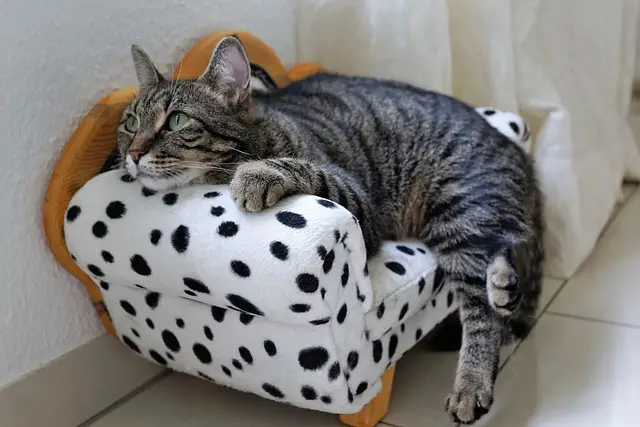If you own a cat, you’ve likely seen them roll on its back when you walk up to them. It’s an adorable behavior and one that is often misinterpreted. But why does your cat roll over on her back, and what does it mean? Let’s break it down and find out.
Why does my cat roll on her back when I walk up to her?
Cats naturally display their bellies as a sign of trust when feeling safe and confident.
Rolling over onto their backs may be an expression of this same feeling.
This behavior has been observed when cats see humans or other animals they are familiar with and comfortable with, like members of the same household.
Additionally, cats might do this to present their scent as a way of marking their territory since many cats have glands on the underside of their bodies that can secrete an odor unique to that cat.
Regardless of why your cat rolls over and presents her belly when you approach her, it is essential to remember never to rub it, as it can make cats feel vulnerable.
Instead, offer gentle chin scratches for a happier result.
The Meaning Behind the Behavior
First, when your cat rolls over on her back, it doesn’t necessarily mean she wants a belly rub or for you to play with her.
This behavior is more likely a signal of trust and relaxation from your feline friend.
Rolling onto her back exposes her most vulnerable areas—the chest and throat—so she’s showing that she feels secure in your presence.
This can be especially true if the rolling is accompanied by purring or kneading—two behaviors cats do when they are feeling content and calm.
The History Behind the Behavior
Cats have been rolling onto their backs since they were kittens. When kittens are with their mothers, rolling onto their backs is a way for them to communicate that they are not a threat—it is also how they learn to trust humans and other cats.
To this day, cats still use the same behavior to show submission while seeking affection from people they know and trust.
It’s also worth noting that cats who spend time outdoors may have different motivations for rolling on their backs; if your outdoor kitty suddenly starts to do this near unfamiliar people or animals, it could mean she’s feeling threatened or scared rather than relaxed and trusting.
Ways that cats show affection
Cats are misunderstood, with many people seeing them as aloof.
The truth is that they can form close and strong bonds with their human companions.
Cats like to show their affection through various methods; this includes meowing or ‘chirping’ when their owners come home, brushing up against legs or hands, purring contentedly, and kneading blankets or sofas.
This behavior has its roots in infancy, where kittens knead the mother’s mammary glands to increase milk flow.
Even after cats have become adults, this instinctive behavior returns during moments of comfort and pleasure. Talking to your cat is a great way to bond and demonstrates appreciation from you – cats will often respond by meowing back or rubbing up against you, showing that they care.
The ways that cats show trust in their owners
Cats are often considered independent animals, but cats show loyalty and trust in their owners through behaviors such as head-butting, purring, chirping, and sleeping close to them.
Head butting signifies that a cat is content with its owner and requested attention from them.
Purring is also an expression of contentment, usually when being petted or scratched. Some cats may even communicate in specific ways known as chirping.
Lastly, a vital trust sign involves sleeping with or close to the owner. This behavior can showcase both comfortableness with the environment and closeness to the person that provides food and shelter.
Cats are complex creatures and exhibit a wide range of emotions through their body language– showing trust being one of them.
Conclusion
When your cat rolls onto her back when you walk up to her, it means she feels secure in your presence and trusts you deeply–what could be better than that? Of course, suppose these behaviors occur in other scenarios where there may be a potential danger, like with strangers or unknown animals.
In that case, it could indicate fearfulness instead of comfortability, so keep an eye out for any signs of distress from your kitty. So next time you see your furry friend roll over on her back, take it as a sign of love and connection.
[su_box title=”Affiliate Disclosure”]This website is supported by its readers. Please assume that all links are affiliate links. If you make a purchase from one of the links we will make a commission from Amazon. Thank you.[/su_box]




